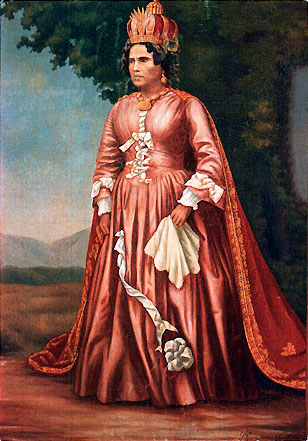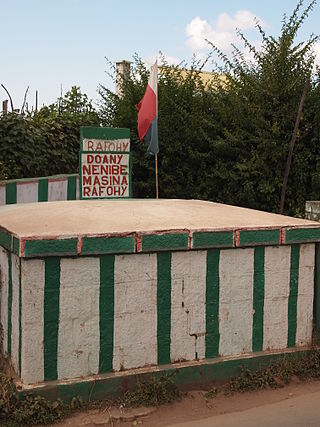Related Research Articles

The History of Madagascar started from the ancient supercontinent of Pangaea, containing amongst others the African continent and the Indian subcontinent, and by the island's late colonization by human settlers from the Sunda Islands and from East Africa. These two factors facilitated the evolution and survival of thousands of endemic plant and animal species, some of which have gone extinct or are currently threatened with extinction. Trade in the Indian Ocean at the time of first colonization of Madagascar was dominated by Indonesian ships, probably of Borobudur ship and K'un-lun po types.

Ranavalona I, also known as Ramavo or Ranavalo-Manjaka I, was the sovereign of the Kingdom of Madagascar from 1828 to 1861. After positioning herself as queen following the death of her young husband Radama I, she pursued a policy of isolationism and self-sufficiency. She sought reduced economic and political ties with European powers, repelled a French attack on the coastal town of Foulpointe, and took vigorous measures to eradicate the small but growing Malagasy Christian movement initiated under Radama I by members of the London Missionary Society.

The Merina people formerly called Amboalambo are the largest ethnic group in Madagascar. They are the "highlander" Malagasy ethnic group of the African island and one of the country's eighteen official ethnic groups. Their origins are mixed, predominantly with Austronesians arriving before the 6th century AD with Untrek Africans resulting in a core population known as Vazimba, later by large number of Javanese and a minority of Arabs, Indians and Europeans. They speak the Merina dialect of the official Malagasy language of Madagascar.

Andrianampoinimerina ruled the Kingdom of Imerina on Madagascar from 1787 until his death. His reign was marked by the reunification of Imerina following 77 years of civil war, and the subsequent expansion of his kingdom into neighboring territories, thereby initiating the unification of Madagascar under Merina rule. Andrianampoinimerina is a cultural hero and holds near mythic status among the Merina people, and is considered one of the greatest military and political leaders in the history of Madagascar.
Zanahary is the personified sky and supreme deity of Malagasy mythology and folklore. He is considered a creator god, having collaborated with the earth god Ratovantany to create humanity; upon death, the soul migrates to the firmament, while the body returns to the earth. For this reason, Zanahary is closely associated with the soul in the indigenous theology as well as ancestor worship. He is a national god of the Merina people, and frequently henceforth appealed to by Malagasy nationalist groups; most notably Ranavalona I promoted the worship of this god over Christianity.
This is a list of rulers and office-holders of Madagascar.
Malagasy mythology is rooted in oral history and has been transmitted by storytelling, notably the Andriambahoaka epic, including the Ibonia cycle. At least 6% of Madagascar are adherents of the religion, which is known as Fomba Gasy, and surveys show it is likely at least half practice some aspects of it. Adherence to Fomba Gasy is high amongst the Sakalava people, as they are reluctant to convert to faiths of foreign origin.

Andriana was both the noble class and a title of nobility in Madagascar. Historically, many Malagasy ethnic groups lived in highly stratified caste-based social orders in which the Andriana were the highest strata. They were above the Hova and Andevo (slaves). The Andriana and the Hova were a part of Fotsy, while the Andevo were Mainty in local terminology.

The KingdomofMerina, also known as the Kingdom of Madagascar and officially the Kingdom of Imerina, was a pre-colonial state off the coast of Southeast Africa that, by the 18th century, dominated most of what is now Madagascar. It spread outward from Imerina, the Central Highlands region primarily inhabited by the Merina ethnic group with a spiritual capital at Ambohimanga and a political capital 24 km (15 mi) west at Antananarivo, currently the seat of government for the modern state of Madagascar. The Merina kings and queens who ruled over greater Madagascar in the 19th century were the descendants of a long line of hereditary Merina royalty originating with Andriamanelo, who is traditionally credited with founding Imerina in 1540.

The Betsimisaraka are the second largest ethnic group in Madagascar after the Merina and make up approximately fifteen percent of the Malagasy people. They occupy a large stretch of the eastern coastal region of Madagascar, from Mananjary in the south to Antalaha in the north. The Betsimisaraka have a long history of extensive interaction with European seafarers, pirates and bourgeois traders, which produced a significant subset with mixed European-Malagasy origins, termed the zana-malata. European influence is evident in the local valse (waltz) and basesa musical genres, which are typically performed on the accordion. Tromba ceremonies feature strongly in Betsimisaraka culture.

The Vazimba, according to popular belief, were the first inhabitants of Madagascar. While beliefs about the physical appearance of the Vazimba reflect regional variation, they are generally described as smaller in stature than the average person, leading some scientists to speculate that they may have been a pygmy people who migrated from the islands that constitute modern-day Indonesia and settled in Madagascar over the course of the period between 350 BCE–500 CE. Scientific evidence confirms the first arrival and subsequent increase of human settlers on the island during this period, but the pygmy theory has not been proven.
Andriamanelo was king of Alasora in the central highlands region of Madagascar. He is generally considered by historians to be the founder of the Kingdom of Imerina and originator of the Merina royal line that, by the 19th century, had extended its rule over virtually all of Madagascar. The son of a Vazimba mother and a man of the newly arrived Hova people originating in southeast Madagascar, Andriamanelo ultimately led a series of military campaigns against the Vazimba, beginning a several-decade process to drive them from the Highlands. The conflict that defined his reign also produced many lasting innovations, including the development of fortified villages in the highlands and the use of iron weapons. Oral tradition furthermore credits Andriamanelo with establishing a ruling class of nobles (andriana) and defining the rules of succession. Numerous cultural traditions, including the ritual of circumcision, the wedding custom of vodiondry and the art of Malagasy astrology (sikidy) are likewise associated with this king.
Ralambo was the ruler of the Kingdom of Imerina in the central Highlands region of Madagascar from 1575 to 1612. Ruling from Ambohidrabiby, Ralambo expanded the realm of his father, Andriamanelo, and was the first to assign the name of Imerina to the region. Oral history has preserved numerous legends about this king, including several dramatic military victories, contributing to his heroic and near-mythical status among the kings of ancient Imerina. The circumstances surrounding his birth, which occurred on the highly auspicious date of the first of the year, are said to be supernatural in nature and further add to the mystique of this sovereign.
Andrianjaka reigned over the Kingdom of Imerina in the central highlands region of Madagascar from around 1612 to 1630. Despite being the younger of King Ralambo's two sons, Andrianjaka succeeded to the throne on the basis of his strength of character and skill as a military tactician. The most celebrated accomplishment of his reign was the capture of the hill of Analamanga from a Vazimba king. There he established the fortified compound (rova) that would form the heart of his new capital city of Antananarivo. Upon his orders, the first structures within this fortified compound were constructed: several traditional royal houses were built, and plans for a series of royal tombs were designed. These buildings took on an enduring political and spiritual significance, ensuring their preservation until being destroyed by fire in 1995. Andrianjaka obtained a sizable cache of firearms and gunpowder, materials that helped to establish and preserve his dominance and expand his rule over greater Imerina.

Queen Rafohy was a Vazimba queen who ruled at Alasora in the central Highlands of Madagascar from 1530 until her death in 1540. Her name means "The Short One." She succeeded upon the death of Vazimba Queen Rangita, who by different accounts was either her mother or her adoptive sister. This confusion in the oral tradition extends to the two women's very identities - according to different accounts, Rafohy may have been the mother of Rangita, and Rangita may have been the mother of the famed king Andriamanelo.

The twelve sacred hills of Imerina are hills of historical significance to the Merina people of Madagascar. Located throughout Imerina, the central area of the highlands of Madagascar, the sites were often ancient capitals, the birthplaces of key public figures, or the tomb sites of esteemed political or spiritual leaders. The first set of sacred sites was designated by early 17th-century king Andrianjaka. The notion was re-sanctified under late 18th-century king Andrianampoinimerina, who replaced several of the earlier sites with new ones. More than 12 sites were thus designated as sacred over time, although the notion of twelve sacred hills was perpetuated because of the significance of the number 12 in Malagasy cosmology. Today, little concrete evidence of the former importance of many of these sites remains, but the significant archeological and cultural heritage of several of the sites has been preserved. The historic significance of the sites is best represented by the Rova of Antananarivo at Analamanga, the ancient fortified city at Alasora, the houses and tombs of the andriana at Antsahadinta and the ancient fortifications and palaces at Ambohimanga, protected as a UNESCO World Heritage Site since 2001.
According to some versions of the genealogy of the Merina people of the central Highlands of Madagascar, Andriandravindravina is the name of the first sovereign of the Highlands. He was not Merina but rather a vazimba, the mysterious first inhabitants of Madagascar that successive waves of settlers encountered upon arrival there. The Tantara ny Andriana eto Madagasikara, the famed genealogy of the Merina aristocracy, states that Andriandravindravina ruled over Ambohitsitakatra in northern Imerina where he was reportedly buried. His three sons were:

The Bezanozano are believed to be one of the earliest Malagasy ethnic groups to establish themselves in Madagascar, where they inhabit an inland area between the Betsimisaraka lowlands and the Merina highlands. They are associated with the vazimba, the earliest inhabitants of Madagascar, and the many vazimba tombs throughout Bezanozano territory are sites of pilgrimage, ritual and sacrifice, although the Bezanozano believe the descendants among them of these most ancient of ancestors cannot be identified or known. Their name means "those of many small plaits" in reference to their traditional hairstyle, and like the Merina they practice the famadihana reburial ceremony. There were around 100,000 Bezanozano living in Madagascar in 2013.

A sampy is an amulet or idol of spiritual and political importance among numerous ethnic groups in Madagascar. Amulets and idols fashioned from assorted natural materials have occupied an important place among many Malagasy communities for centuries. Sampy can be classified into two categories. Those that are meant to bless and protect an entire community by serving as a deity figure, and individual amulets that people wear on their person as protection. The latter are called Ody. The Sampy are sometimes considered autonomous beings; having their own name, their own characteristics, their own purposes, their own conditions and even their own home. Among the most famous are Ikelimaza, Rafantaka and Ramahavaly.
A rova is a fortified royal complex built in the central highlands of Madagascar by Merina of the Andriana (noble) class. The first rova was established at Alasora by king Andriamanelo around 1540 to protect his residence throughout a war with the neighboring Vazimba. Rovas are organized according to traditional symbolic notions of space and enclose the royal residences, the tomb of the founder, and a town square marked with a stone. They are protected with walls, trenches and stone gateways and are planted with fig trees symbolic of royalty.